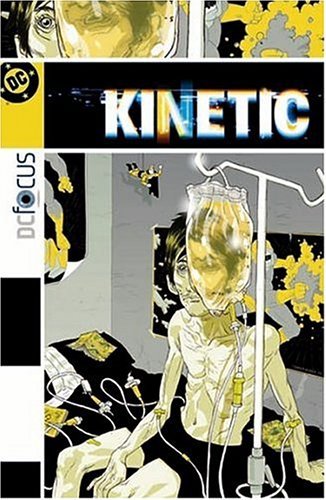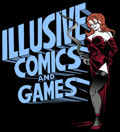| Kinetic
The really
great comics leave us with something after we’ve finished
them. Sometimes it’s something as simple as a line
of dialogue that echoes inside our heads for hours, trying
desperately to explain itself to the reader.
Sometimes
it’s something more, or possibly worse; I remember
after I’d read V for
Vendetta for the first time, it was something like
1:00am. I kept staring up at the ceiling of my bedroom,
not really thinking about anything but thinking. I wasn’t
geeking out over what a great comic I’d read or how
wonderful Moore was as a writer, but I was remembering something
that was in the introduction Moore wrote to the graphic
novel, when he was talking about the British then recently
(in the 1980s) passing Clause 28, which called for homosexuals
to be rounded up and placed in concentration camps to stem
the tide of AIDS. He said something to the effect of “England’s
not a nice place anymore. I don’t think I want to
live here.”
This
is bad paraphrasing on my part, but that line kept flying
through my head as I replayed every panel of that comic
book. It’s been years since that night, and I’ve
re-read V since then with no ill-effect, but what
I remember most after reading it for the first time is that
I was afraid. Not of a totalitarian regime of English Thatcherites
or a knife toting, bomb-happy vigilante; I think I was scared
of the comic itself. I think I was scared that within two
slim pieces of cardboard resided a story that was powerful,
frightening, and horrible, that showed every facet of the
human condition from the soul-gutting depths of despair
to the freedom and dignity inherent in the human spirit.
Yeah it was a story, with characters interacting and all
the regular stuff, but underneath the plot and the themes
and the dialogue was something frightening.
The
best I can do to describe it might be to say that it’s
the same as when you’re standing on the edge of a
cliff looking down. Your feet are stable and safe and you
know this, but when you look over that edge, suddenly you’re
not fine and you’re not stable and your heart is beating
faster than it should. Your knees get weaker and you have
to step back, only you can’t step back after you’ve
read something. You just stare it right in the face and
hope it goes away.
I’ve
never felt this with another comic until now, some time
this afternoon when I read Kinetic. The story the
creators tell is a story that captures humanity in ways
rarely seen in a book about people with superpowers. It
gives a brutal and honest account of the teenage condition
and demonstrates the utterly insane thoughts that can entrench
themselves within our minds at that age. And it shows us
that those thoughts never really leave us.
The
book was created by Allan Heinberg (The O.C., Young
Avengers) and Kelley Puckett (Batgirl), penned
by Puckett himself with artwork from Warren Pleece. It is
the story of Tom Murrell, a boy stricken by diseases of
every kind, sickly and infirmed since early childhood. His
only friend is his mother, a woman so obsessed with keeping
her son alive that life itself has lost any other meaning,
yet a woman that both hates and loves her son for the burden
he represents. Tom hates his life to the point of considering
death as the better deal. Then Tom discovers that he has
powers.
Here
is where we should see the emergence of the classic troubled-teen-gets-powers
scenario, wherein the teen gets powers, does some good,
becomes a hero, etc. We do not actually see that. Instead
the narrative takes a turn for the original in that nothing
happens. Tom’s weakness, his insular life, is not
escapable. Even with a body powerful enough to crush boulders,
he is still a prisoner in his own mind, monologing his every
thought and action inside his own head. He has fantasies
about using the powers he has, but never actually acts on
them. He has dark thoughts that seem horrific, but Puckett
subtly reminds the reader that these thoughts are the same
ones we all have: violent urges, thoughts of using force
to get what we want, etc.
And
because these thoughts are self-contained within the mind
of the main character, we see them as he does, with no outside
moral framework. The reader is forced to judge Tom by his
own standard of moral behavior, which is extremely intriguing,
forcing us to both be disgusted by and feel empathy for
him.
The
artwork by Pleece is excellent, owing a lot to the choice
in coloring done by Wendy Broome and Brian Haberlin; the
entire comic is colored in only varying shades of red and
blue, with black inking and gray shading. Pleece’s
style is highly reminiscent of Daniel Clowes' work on comics
like Eightball and Ghost World, with a
style stressing facial expression and realism.
Moreover,
Pleece’s style of pacing is nothing short of excellent;
he is willing to go from a full page panel to cramming sixteen
panels to a page, and because he has a slow revealing style
that establishes each panel, it never feels disjointed or
wrong. The story flows easily, making it a literal page
turner, as well as functioning parallel to the high and
low points of Puckett’s script. Combined with the
contrasting color structure, the artwork on this, while
not always the perfect aesthetic visual, is some of the
most in-depth and engrossing artwork I’ve seen in
comics.
And
here I’ve described, maybe even gushed over all the
very good technical aspects of this comic, and as I look
down on it lying on my desk, there is still a small tick
at the back of my neck. It’s scary how very much the
main character’s thoughts are transmitted to the reader.
The writer has created a story that demands you feel what
the character feels, never allowing us to step outside the
small world of Tom’s head. We really experience what
he feels, with no room for anything else.
And
I think that’s what the fear might be: that we could
get pulled in or pulled over the edge of a story and fall
into it. The good stories leave us with something. They
leave us with a clear understanding of the power one story,
one tale, one character can have over us. They show us their
influence and when we see it, we cringe a little because
we didn’t know it was so easy to take us over. Kinetic
is one of those stories, and if you can look over the
edge and not stumble, is well worth $9.99 for eight issues
of material.
Kinetic
|






